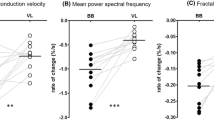Summary
The training effect on the human arm flexor was studied by subjecting 5 healthy males. The training was made by isometric maximum contraction, 3 times (10 seconds/bout) a day, every day except Sunday for 100 days. Ultrasonic photography was employed to estimate the cross-sectional area of the muscle.
-
1.
The muscle training of 100 days increased the maximum strength by 91.7% and the cross-sectional area of muscle by 23.0%.
-
2.
The average values of strength per unit cross-sectional area of muscle increased from 6.3 to 10.0 kg/cm2 after 100th day of training at extended position of arm, from 4.7 to 7.5 kg/cm2 at flexed position of arm.
-
3.
The increase of maximum strength was associated with the increase in cross-sectional area and the increase in strength per unit cross-sectional area.
Similar content being viewed by others
References
Pick, R.: Handbuch der Anatomie und Mechanik der Gelenke unter Berücksichtigung der bewegenden Muskeln. Jena: Fischer 1910.
Franke, F.: Die Kraftkurve Muskeln bei willkürlicher Innervation und die Frage der absoluten Muskelkraft. Pflügers Arch. ges. Physiol.184, 300–322 (1920).
Hellebrandt, F. A., Parrish, A. M., Houtz, S. J.: Cross education. The influence of unilateral exercise on the contralateral limb. Arch. phys. Med.28, 76–85 (1947).
Hermann, L.: Zur Messung der Muskelkraft am Menschen. Pflügers Arch. ges. Physiol.73, 429–437 (1898).
Hettinger, Th.: Isometrisches Muskeltraining. Stuttgart: Thieme 1968.
—: Physiology of Strength. Springfield (Ill.): Thomas 1961.
Ikai, M., Fukunaga, T.: Calculation of muscle strength per unit cross-sectional area of human muscle by means of ultrasonic measurement. Int. Z. angew. Physiol.26, 26–32 (1968).
—, Steinhaus, A. H.: Some factors modifying the expression of human strength. J. appl. Physiol.10, 157–163 (1961).
—, Yabe, K., Ischii, K.: Muskelkraft und muskuläre Ermüdung bei willkürlicher Anpassung und elektrischer Reizung des Muskels. Sportarzt und Sportmedizin. Heft5, 197–211 (1967).
Morris, C. B.: The measurement of the strength of muscle relative to the cross-section. Res. Quart. Amer. Ass. Hlth phys. Educ.19, 295–303 (1948).
Wilkie, D. R.: The relation between force and velocity in human muscle. J. Physiol. (Lond.)110, 249–280 (1950).
Author information
Authors and Affiliations
Rights and permissions
About this article
Cite this article
Ikai, M., Fukunaga, T. A study on training effect on strength per unit cross-sectional area of muscle by means of ultrasonic measurement. Int. Z. Angew. Physiol. Einschl. Arbeitsphysiol. 28, 173–180 (1970). https://doi.org/10.1007/BF00696025
Received:
Issue Date:
DOI: https://doi.org/10.1007/BF00696025




